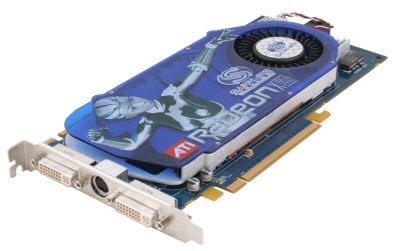Sapphire Radeon X1950 Pro
Today's high-end flagship video cards may cost an arm and a leg, but that segment of the market is not where the real money is. The big money is made in the low-end and mid-range (or mainstream) segments of the market. It's simple really: most people shopping for a video card have budgeted $100-250, while relatively few have $400+ budgets for just graphics.
Less than two months ago, ATI dropped a new pixel-pushing soldier into the battle for mid-range supremacy. That soldier came in the form of the Radeon X1950 Pro, and it fights the good fight for about $200. Today, we'll be looking at Sapphire's version of the X1950 Pro.
One of the coolest features of the X1950 Pro is its new Native CrossFire support, which means you won't need a master CrossFire card with the X1950 Pro if you want to run in multi-GPU mode. And no more clunky dongle; a welcomed change indeed. In addition to the Native CrossFire support, the X1950 Pro features 256MB of GDDR3 memory, 36 pixel shader processors and 8 vertex shader processors. The specs look good. But how does it really perform? Let's put Sapphire's X1950 Pro through its paces and find out.

|
|
|
| Features | |
|
RADEON X1950 PRO core (580MHz) 256MB GDDR3 onboard memory (1400MHz) Windows Vista 3D environment Support 36 pixel shader processors 256-bit Memory Bus PCI Express x16 / CrossFire support Pixel Shader Version 3.0 Video Acceleration of: MPEG-2, MPEG-4, DivX, WMV9, VC-1, and H.264 Dual DVI Video-In and Video-Out |
|
| Technical Specifications | |
|
Shader Technology
Anti-Aliasing and Anisotropic Filtering
3Dc+TM - Advanced Texture Compression
Ring Bus Memory Controller
|
Avivo Video and Display Engine
CrossFire

|
The Sapphire X1950 Pro comes nestled in typical Sapphire packaging; there's the iconic, futuristic, sexy female robot mascot, the teaser window and all the marketing logos. In case you're not sure, big stickers point out that the card is HDCP and Windows Vista ready.
Inside the box, Sapphire packs a couple handfuls of accessories: an S-video cable, a composite video cable, a PCI Express power cable, two VGA-to-DVI adapters, an HDTV-out cable, a composite-to-S-video adapter, and a CrossFire ribbon connector. In addition to the accessories, Sapphire includes a multi-language user manual, an installation driver CD, CyberLink PowerDVD 6 (2-channel version), and The Da Vinci Code game. It's nice to see a game included, but we doubt many gamers will be very excited about The Da Vinci Code game in particular.











